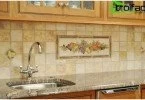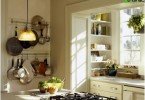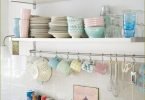Which laminate is better to choose for the kitchen
Without exaggeration, a kitchen can be called the soul of any home. A special atmosphere always reigns here, it smells of delicious food and the family gathers for lunch or dinner. But here water and oil spill, stubborn stains appear, even dishes can break and almost all of these troubles are taken by the floor. It should be durable, easy to clean and, of course, beautiful. More recently, the family of flooring for the kitchen replenished the laminate. Not sure if this is practical? If you figure out which laminate to choose for the kitchen, you will fall in love with this material, and the soul of your home – the kitchen will delight you with beauty and freshness for a long time.
Content
- Why choose laminate flooring?
- Laminate for the kitchen: choice
- Characteristic of moisture resistant laminate
- Waterproof laminate, what is the difference
Why choose laminate flooring?
The versatility of the laminate strikes the imagination of even the most sophisticated esthetes. It can imitate any kind of wood, natural stone, ceramics and many other materials. The surface of the laminate can be smooth, and can repeat the texture of wood, stone and even fabric, it can dazzle or be dull. Whatever natural flooring material you would like in the kitchen, the laminate will fulfill any of your wishes, but the cost of the material will be significantly lower compared to the price of the original.
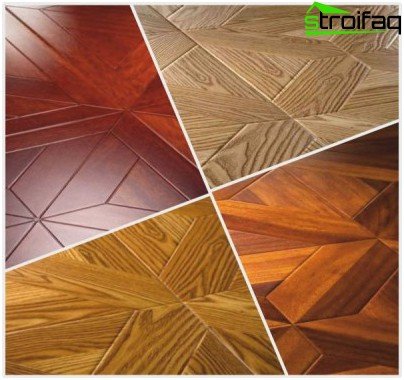
Laminate can imitate any kind of wood, natural stone, ceramics and many other materials
Laminate is very easy to install, it can even be laid on an old floor covering if it does not need to be leveled. You will not get bogged down in repairs for long days and weeks, because laying a laminate floor will take only a few hours.
Finally, some types of laminate flooring blend perfectly with any “warm floor” construction. If this option is also included in your plans, when buying a laminate, check if there is an appropriate marking.
Laminate for the kitchen: choice
What properties of the material should be paid attention to when considering a laminate for a kitchen in a store – how to choose? Laminate flooring for the kitchen should be durable, wear-resistant and moisture-proof.
Wear resistance
In terms of wear resistance, all laminate flooring is divided into the following classes:
- 21, 22, 23 – for residential premises;
- 31, 32, 33 – for rooms with high traffic.
If the repair budget is very limited, you can put a laminate of the 23rd wear resistance class in the kitchen, but such a floor will last only 5-7 years. However, for lovers of frequent interior changes, this option is quite acceptable..
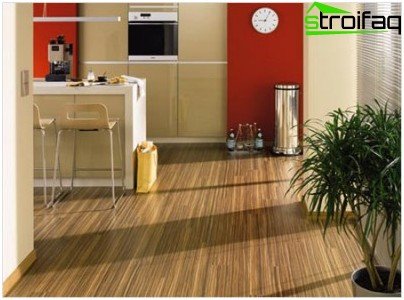
Laminate flooring of wear classes 31 and 32 are designed for floors of offices, shops, cafes and restaurants, which means that in kitchens of residential apartments and houses this floor will withstand any mechanical stress and shock, it will not scratch, and it will last for many years.
Moisture resistant
The moisture resistance indicator of a kitchen laminate is equivalent in importance to the wear resistance indicator: after all, this room is second only to the bathroom in terms of the amount of spilling water and fumes. Relatively recently, Aqua markings appeared on the packaging of laminate of the latest generation, and by the nature of their relationship with water, laminated floor coverings are:
- moisture resistant;
- water resistant.
Particularly durable boards are used as the basis of the moisture-resistant laminate, and the locks are covered with water-repellent wax impregnation, which is confirmed by the Aqua marking. With the external similarity between the moisture-resistant and waterproof laminate, there are several differences.
Characteristic of moisture resistant laminate
The basis of moisture-resistant laminate is a durable MDF board with a fibrous structure of high density. The outer polymer layer provides excellent water resistance to the surface of the material, but not to the joints between the panels. Moisture trapped through the joints leads to swelling of its wood structure and, as a result, to deformation of the outer layer. Moreover, even with full drying, the initial appearance of the laminate floor is no longer restored. Of course, a moisture-resistant laminate can be laid on the kitchen floor and it can maintain an attractive appearance for a long time with gentle care. To do this, it is necessary to regularly process the seams-joints with special mastic and very quickly remove the spilled water.
Waterproof laminate, what is the difference
Unlike a moisture-resistant fellow, a waterproof laminate is endowed with the best water-repellent characteristics among the entire family of laminated floor coverings. This superiority is ensured by the internal structure, the basis of which is not a wood, but a plastic plate. It is not able to absorb moisture, which means it does not swell and its structure does not deform even after prolonged contact with water. The surface of the plastic base of the waterproof laminate is covered with a very strong moisture-resistant adhesive, on which a decorative layer is glued, and then a water-repellent polymer of increased strength. The result is a laminate floor that is resistant to moisture and mechanical stress..
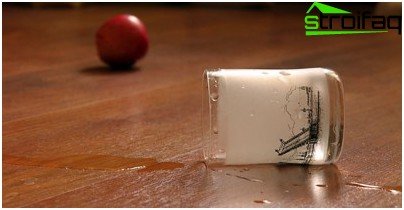
Waterproof laminate has the best water repellent performance among laminate flooring
You are still thinking, choosing a laminate for the kitchen: which is better? Of course, waterproof, which can withstand not only frequent washing of the floor, but even a small flood, if the neighbors suddenly flood from above or a water pipe leaks.
The advantages of the laminate floor in the kitchen
In favor of the laminate as a floor covering for the kitchen, its advantages say:
- respectable appearance;
- abrasion resistance;
- simplicity and speed of installation;
- hygiene;
- combination with any design of the “warm floor” system;
- affordable price.
Fans of natural finishing materials and eco-design with a limited budget choose a laminate for interior decoration: after all, it looks so much like natural wood or stone, and its affordable price allows you to realize any design ideas without limiting yourself in anything.
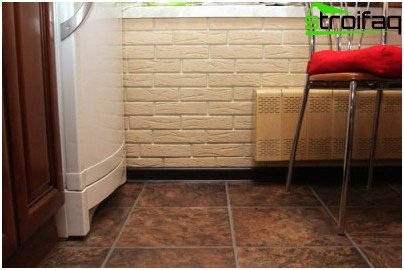
The diverse design of the laminate allows you to realize any design ideas in the kitchen
Practical homeowners value simplicity of laying most of all in this material. After all, even a layman can easily and quickly cope with this work, following the masonry instructions from the manufacturer.
Mistresses really like the ease of care for the laminate. It does not respond to temperature changes, it is easy to wash, there are no scratches on it and, finally, the most difficult stains are easily removed from it, starting from fruits and fats and ending with fuel oil and nail polish.
Laminate is much warmer than ceramic tiles, it is pleasant and safe to walk barefoot on it, and this is so important if there are small children in the family. In addition, the laminate is suitable as a finishing floor covering for the “warm floor” system. For natural wood floors, such a luxury is not available. Finally, no matter what natural material mimics a laminate floor, it always looks respectable.
Disadvantages of laminate for the kitchen
With many indisputable advantages of the laminate, when choosing this material for the floor in the kitchen, one should also take into account its disadvantages, which can be minimized under certain circumstances:
- sensitivity to moisture;
- low sound insulation;
- formaldehyde resin content.
The most vulnerable spot and the main disadvantage of all types of laminate, except waterproof, is the increased sensitivity of its joints to prolonged exposure to moisture. And if during normal use careful care will save you from possible troubles, then in case of emergency situations, the laminate floor will not be restored. Will have to completely replace it.
The low soundproofing of the laminate is manifested in the too sonorous sound of steps. If it really will interfere with the inhabitants of the house, you can use slippers with soft soles.
Laminate flooring, in addition to water-resistant, like many other wood-based materials, may contain formaldehyde resins that are unsafe for human health. When buying a laminate, you must carefully study the labeling on the package. If there is an E-1 badge there, then the formaldehyde content in the material is minimal and nothing threatens your health – feel free to buy.
Specific styling features
Laminate floor in the kitchen, if desired, even a layman can lay on their own. It is recommended to buy material with a small margin, about 5-10% more than the kitchen area. This condition is especially important if your kitchen has a complex shape. Install the panels in strict accordance with the manufacturer’s detailed step-by-step instructions..
There are two ways to lay laminate:
- glue;
- castle.
With the adhesive method of laying the laminate panel, they are glued to the base and glued together. This connection is more hermetic, but less and less used..
Castle laying system is more modern and it is offered by most leading manufacturers of flooring. This method is very simple to implement, and its advantage is the ability to dismantle. That is, if necessary, at any time, such a laminated floor can be disassembled and re-laid in any other room.
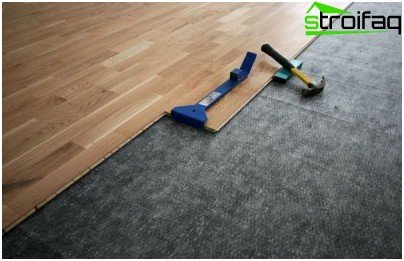
Laminate can be laid on any foundation, including wooden floors, linoleum and short-pile carpeting
Laminate flooring can be laid on any foundation, including wooden floors, linoleum and short-pile carpeting. Of course, subject to a good flat surface and high-quality waterproofing of the base.
Laminate panels can be laid along or across the window opening or diagonally. Laying on the diagonal is the most difficult to perform and if there is no confidence in their own skills, it is better to entrust this work to an experienced specialist.
An important secret to laying laminate flooring: the joints of panels laid in the direction of light are almost invisible. By combining two or more types of laying, you can visually expand the space of the kitchen, change its geometry if necessary, and designate functional areas.
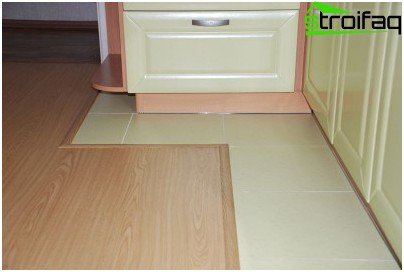
In different functional areas of the kitchen, you can combine ceramic tiles and laminate or laminate
In addition to different laying methods, in different areas of the kitchen you can combine ceramic tiles and laminate or laminate “under the tile” in the working area and laminate “under the parquet” in the dining room. Too small a kitchen does not recommend the installation of combined floors – they visually reduce the room.
Laminate Care in the Kitchen
Laminate floors are antistatic and almost do not attract dust, and therefore daily cleaning of the kitchen can only be done by wiping the floor with a well-wrung cloth and only in case of severe pollution can it be washed occasionally with plenty of water and then wiped dry.
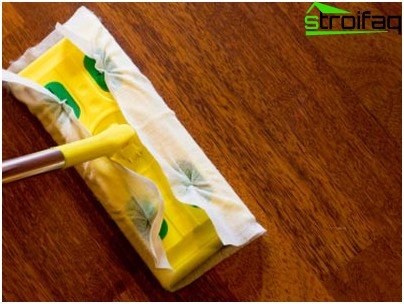
Daily cleaning of the laminate floor in the kitchen can be reduced only to wiping it with a well-wrung rag
To seal and maintain the joints between the laminate panels, they should be regularly treated with branded wax-based formulations developed by manufacturers. The same compounds can also mask scratches and remove complex spots, while maintaining a presentable appearance of the laminate floor..
Scratches on the floor can be avoided altogether by sticking felt pads on the legs of the refrigerator, kitchen furniture and other heavy objects in the kitchen.
If you don’t save too much and buy a high-quality waterproof laminate of the corresponding wear resistance class, maintaining the cleanliness and freshness of the floor will not cause you much trouble and it will delight you with its beauty for a long time.
The choice is made. The laminate floor priority list outweighed the short list of disadvantages. It remains only to study the styling technology and proceed with the responsible business. To help you, information on a video demonstrating the rules for diagonal styling:


